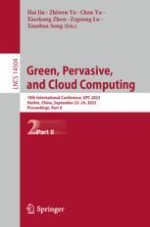2024 | Buch
Green, Pervasive, and Cloud Computing
18th International Conference, GPC 2023, Harbin, China, September 22–24, 2023, Proceedings; Part II
herausgegeben von: Hai Jin, Zhiwen Yu, Chen Yu, Xiaokang Zhou, Zeguang Lu, Xianhua Song
Verlag: Springer Nature Singapore
Buchreihe : Lecture Notes in Computer Science
